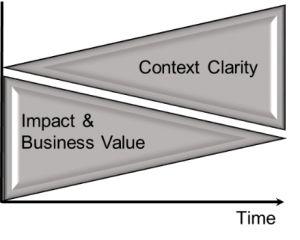
Time Value of Information
Fans of Malcolm Gladwell’s Blink will surely agree: In many situations, it makes sense to act promptly and decisively upon arrival of information indicating a problem.
You can clearly apply this logic in industrial manufacturing setting. For instance, if a machine on the manufacturing line has drifted out of spec and starts spewing bad parts, it should be shut down immediately in order to reduce the number of bad parts it produces. Then, the machine needs to be repaired equally expeditiously in order to restore production as soon as possible. In this example, the impact, or the business value, of the decision is the highest when a quick and decisive action is taken. The longer we wait to shut down production, the more bad parts are going to be produced and scrapped.
As Lee Iacocca remarked: “Even a correct decision is wrong when it was taken too late.”
But all too often, and here I take exception to Gladwell’s theory, decision makers do not have enough information to make such quick decisions. They need additional information before they can act, information that creates sufficient and accurate context to allow them to assess the situation in order to weigh alternate responses and make the right decision.
Back at our manufacturing line, if there are multiple machines and processes that are responsible to part manufacturing and might be the culprit of those defective parts, then we need to consider several options before we can take action, because shutting down the entire line and restarting it will be too costly. Worse, a hasty, ill-informed action may easily result in damage or injury.
 In other words, in many instances we might need to spend time collecting and analyzing information to create sufficient context in order to make the right decision. In other words, the more time we spend on analyzing the problem (within reason, of course), the better decisions we can make. The value and utility of this kind of information actually improves over time.
In other words, in many instances we might need to spend time collecting and analyzing information to create sufficient context in order to make the right decision. In other words, the more time we spend on analyzing the problem (within reason, of course), the better decisions we can make. The value and utility of this kind of information actually improves over time.
Procrastination Is Not Such a Bad Thing
Sometimes, the most effective way to tackle a problem or a new creative assignment is to put it off for a while. As writer and psychologist Maria Konnikova observed: “You’re actually doing the smartest and most productive thing in the world if you waste time.”
Wharton Business School organizational psychologist and self-described “pre-crastinator,” Adam Grant argues that moderate procrastination is a useful habit for original thinkers: “Our first ideas, after all, are usually our most conventional.” He names several out-of-the-box thinkers that includes Steve Jobs and Martin Luther King as being habitual procrastinators.
The purpose of procrastinating, says Konnikova, is “to make sure to have perspective before you start working.” In other words, allow the necessary time, information aggregation and analysis to create sufficient context for the right decision; context that we know is complete, relevant, error-free, and sufficiently up to date.
We realize, of course, that often there is a conflict between the need to make a quick decision that yields a greater business impact, but is accompanies by a greater risk, and the need to make sure sufficient information and context were used to make the correct decision. And, at the same time, waiting too long in analysis-paralysis and not making timely decision is also fraught with waste and risk.
The Connected Enterprise
The industrial Internet of Things (IoT) and the connected enterprise shortens the time to create decision-making context. It aggregates information from multiple information sources, including machine-generated and enterprise data repositories to create high-value decision-making context to allow the organization just right level of procrastination.
(Portions of this article appeared in The Outcome Economy: How The Industrial Internet of Things is Transforming Every Business)
Image: Soft Watch at the Moment of First Explosion by Salvador Dali (c. 1954)
